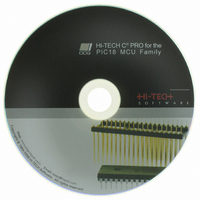SW500007 Microchip Technology, SW500007 Datasheet - Page 46

SW500007
Manufacturer Part Number
SW500007
Description
PICC-18 PRO
Manufacturer
Microchip Technology
Type
Compilerr
Series
PIC18r
Specifications of SW500007
Supported Families
PIC18
Core Architecture
PIC
Software Edition
Professional
Kit Contents
Software And Docs
Mcu Supported Families
PIC18
Tool Function
Compiler
Tool Type
Compiler
Lead Free Status / RoHS Status
Not applicable / RoHS Compliant
For Use With/related Products
PIC18 Series
Lead Free Status / Rohs Status
Lead free / RoHS Compliant
Other names
015P
778-1002
778-1002
778-1002
778-1002
- Current page: 46 of 486
- Download datasheet (4Mb)
Processor-related Features
To read a byte of data from an address in EEPROM memory, and store it in a variable:
For convenience, __EEPROMSIZE predefines the number of bytes of EEPROM available on chip.
3.2.4.2 Flash Access
To copy a block of code/data to an area in flash memory:
To read a byte of data from an address in flash memory, and store in a variable:
3.2.5 Peripheral Memory Ranges
Some devices have sections of memory that are intended for use by its peripherals or the device
itself. In these instances it may be beneficial to exclude these ranges from the compiler’s available
resources. Conversely, if you can be sure that a particular resource will not be used by the device
(and it is safe to do so), you may benefit by making the resource available to the compiler. Typical
examples of these types of memory resources are on-chip debug facilities, boot sectors in program
space, DMA and USB data buffers. These memory ranges can be included or excluded from the
memory ranges available to the compiler via the driver’s –RAM or –ROM options.
Those peripheral ranges that can be referred to by name are detailed in Table 3.1.
32
EEPROM_WRITE(address,value);
variable=EEPROM_READ(address);
flash_write(source_pointer, length, dest_pointer);
variable=flash_read(address);
T
Consider this example. A device has RAM in the address range from 0 to 7FFh, how-
ever the range 400h to 7FFh is dual-port RAM shared with the device’s onboard USB
module. This memory range by default is unavailable to the compiler. If a program
being built for this device is running short on RAM and doesn’t use the USB facility, it
would make sense to avail this memory range to the program. One way that this may be
done is to define and add the range using the driver option --RAM=default,+400-7ff.
Alternately, if the driver recognises the resource by name, the option could be modified
to say --RAM=default,+USBRAM.
UT RIAL
C Language Features
Related parts for SW500007
Image
Part Number
Description
Manufacturer
Datasheet
Request
R

Part Number:
Description:
Manufacturer:
Microchip Technology Inc.
Datasheet:

Part Number:
Description:
Manufacturer:
Microchip Technology Inc.
Datasheet:

Part Number:
Description:
Manufacturer:
Microchip Technology Inc.
Datasheet:

Part Number:
Description:
Manufacturer:
Microchip Technology Inc.
Datasheet:

Part Number:
Description:
Manufacturer:
Microchip Technology Inc.
Datasheet:

Part Number:
Description:
Manufacturer:
Microchip Technology Inc.
Datasheet:

Part Number:
Description:
Manufacturer:
Microchip Technology Inc.
Datasheet:

Part Number:
Description:
Manufacturer:
Microchip Technology Inc.
Datasheet:










